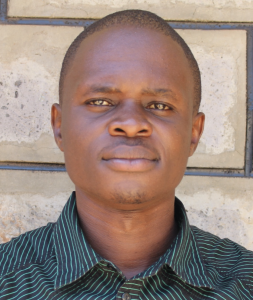August, 2019: Dr. Gimose Secondary School Project Complete!
Dr. Gimose Secondary School in Kenya now has access to a new source of safe, clean water thanks to the completion of their rain tank, which has the ability to collect 50,000 liters of water. We installed new latrines for students, handwashing stations, and we trained students and staff on improved sanitation and hygiene practices. All of these components work together to unlock the opportunity for these students to live better, healthier lives.

Rain Tank
Construction for this 50,000-liter rain tank was successful!

Parents, staff, and students helped our artisans gather everything needed for construction. All the while, women cooked meals for the artisans, and the school provided accommodations for the artisans during their work. Local men and women helped our artisans with their manual labor, too.

Everyone lends a hand
The process officially began with the artisan's arrival, which was a dream come true to the school as they had longed to see the day become a reality. We immediately got to work, with our staff and school administration looking around the school compound to try and determine the best location for a new rain tank. This needed to be the best site with good, clean roofing to catch the rainwater.

Tank foundation begins

Delivering stones for the tank foundation
Then, we cleared the site: excavating the soil within the required measurements to make level ground for the tank foundation. The foundation was cast by laying hardcore on level ground and then reinforcing it using steel, concrete and waterproof cement.

Looking down on the rain tank
Both the drawing pipe as well as the washout pipe were affixed as the foundation was laid. The wall was built with ferro-cement techniques through 6 layers. The inner wall was plastered while rough casting was done on the outer part. Finally, the catchment area was dug, plastered, and a staircase installed.
Being rainy season, the normal working days were sometimes interrupted with heavy rains but this did not challenge our artisan as he was well prepared for any contingencies.

Installing the tap and manhole cover

Tank dome almost complete
Dome construction could begin after the superstructure had been given enough time to settle. The manhole cover was fitted, inlet pipes were connected to the roof gutters, inlet screens, ventilation pipes (breathers) and overflow pipes were all done to standard.
Once finished, the tank was given 3 to 4 weeks to undergo complete curing before it was cleaned and handed over to Dr. Gimose Secondary School, though we will continue to offer them unmatchable support as a part of our monitoring and maintenance program.

Immediately after conducting the training, we gathered at the rain tank for the official handing over process. Both the field officer and the headteacher gave a speech of thanks, after which the field officer handed over the project to the school.
The celebration was a great chance for us to acknowledge the school administration and students as the primary parties entrusted with the tools we’ve given, as well as remind them of our continued support as they develop.
"This water point has indeed come at the right time when the school highly needs it," said sanitation teacher Mr. Sadanji Chiseve.
"From today, our students will no longer go to the river to fetch water as we now have a facility of our own. We are grateful to our partners for having considered our school. We will guard this facility at all times."

Mr. Sadanji Chiseve
Head Teacher Mrs. Sarah Esitika echoed Sadanji's sentiments.
''Installation of these facilities will be of great help to the school as [they] will allow our students [to] have ample time in their studies," she said.

VIP Latrines
This project funded the installation of 6 new ventilated improved pit (VIP) latrines. All of these new latrines have cement floors that are designed to be easy to use and clean. And with a rain tank right on school property, there should be enough water to keep them clean.

Brave girls posing outside their new latrines during a passing rainstorm!
Handwashing Stations
The 2 handwashing stations were delivered to the school and handed over to the Child to Child health club. These were placed outside of the girls’ and boys’ latrines to encourage handwashing after latrine use.
Health club members teach other students how to properly wash their hands at the stations, make sure the stations are filled with water and work to ensure that there is always soap or ash available.

Student using a handwashing station
New Knowledge
Hygiene and sanitation training was scheduled with the help of the school principal and the Head Teacher, Mrs. Sarah Esitika, who ensured that the training date would be convenient for students, staff, and parent representatives. Individual teachers helped by selecting students from each class to represent the others.
When our team arrived at the school for training, the weather was cold given the current rainy season but we held the lessons inside the school building so that w would not be affected by the harsh weather.
Before the official training began, we were given the opportunity to speak with the entire school community, which was a great chance to connect with students and staff. 19 people attended training, which was 4 more than we had expected. We gladly welcomed the additional, interested students to join us.

Taking notes at training
A number of topics were covered, including personal hygiene such as bathing, oral hygiene, and handwashing with soap as a barrier from germs; and operation and maintenance of the new facilities, with each person understanding their role for long-lasting clean water and good health.
The new student health club will be greatly involved in project management and will be responsible for encouraging good health and hygiene practices amongst their peers, teachers, and the larger community.

Beverlyn Manayo leads a training activity
Having volunteered for the training, the participants gave it their all. We experienced total involvement of the participants during the entire training. At the time of closure, we were surprised that the participants were not ready to let it go, requesting more and more time and topics from the facilitators.

Student Bynum Savatia leads an activity
Leadership and Governance was a particularly fun and unique session. The facilitator took the participants through the qualities of a good leader with a focus on various animals in mind, including a chameleon, giraffe, lion, tortoise, elephant, and cat. After much thought and discussion by the students, it was concluded that the lion, elephant, and giraffe had the required qualities of a good leader.

Beverlyn Minayo
When it came to students voting for their health club leaders, however, something very interesting happened! During the election stages, the sanitation teacher Mr. Sadanji Chiseve had to intervene when he noticed the males were dominating the positions.
This made him disqualify other boys for vying in other top positions, preserving them for the girl child. This did not please the boy child at first, but they learned that to promote gender equity they would have to relinquish some power in these positions.

Dental hygiene training
Another special moment came during the dental hygiene training, which we were able to complete with the entire school before we paired down to the smaller group. During demonstration time, the participants were left amazed particularly with the quantity of toothpaste applied on the toothbrush.
The participants had in mind that the bigger bead of toothpaste you apply, the better one brushes their teeth! We explained that while this is not necessarily true, their brushing would be enhanced if they used enough toothpaste.

Valentine Sonny
"I am glad [I was] considered for today's training. It has been timely for all of us, and this is the time we come together and sensitize the entire community on maintaining proper hygiene and sanitation standards. We promise to be ambassadors of today's training so that our community lives a healthy life," said 17-year-old student Valentine Sonny.
Thank you for making all of this possible!


 Rainwater Catchment
Rainwater Catchment
 Rehabilitation Project
Rehabilitation Project









































